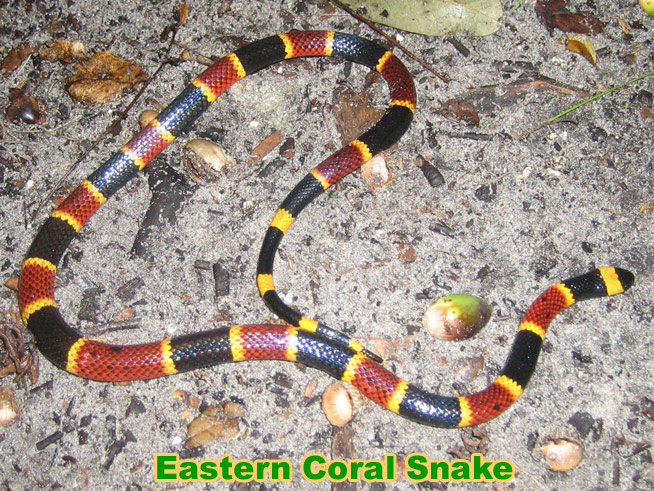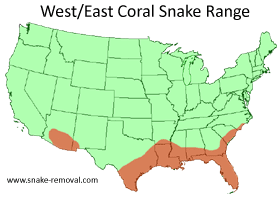
Coral Snake Appearance: There are many varieties of coral snakes throughout the Americas,
but we will address the USA snakes. The most common species in the United States have a universal red-yellow-black-yellow pattern. Not all coral snakes have the same color scheme, so it is important to be familiar with the snakes specific to your region. This snake is small in comparison to other venomous snakes in the United States. At its longest, an adult can measure around thirty inches. The colorful body is slender and lacks real variance in width. The head blends seamlessly into the body with no distinctive neck. The head of this species of coral snake is always black.

Unlike other venomous snakes, the coral snake has round pupils, a blunt head, and no heat sensing pits. Its venom sacks are not attached to the fangs but are adjacent to the teeth, permeating the puncture holes as the snake latches onto a victim. Contrary to common belief, the maximum amount of venom can be delivered without chewing; the venom delivery is related to the duration of time the snake is attached, not how many times it bites its prey. Multiple bites do facilitate quicker venom transfer, but do not necessarily affect the quantity.
Coral snake venom is neurotoxic, another fact which distinguishes it from other North American poisonous snakes. Neurotoxic venom affects the way the brain communicates with muscles, slurring speech, affecting movement, and ultimately ceasing cardiac or respiratory function. A bite from a coral snake can go without symptoms for as long as twelve hours.
Unfortunately, due to their bright colors, coral snakes are a favorite of children. Many of the reported bite cases are due to the curiosity of a young person who tried to pick up the reptile. For this reason, it is good that coral snakes are shy and rarely spotted. To avoid trouble, read more about the Snake Rhyme Poem, and information about the Coral Snake Look Alikes, such as the Scarlet Kingsnake, to find out what does a coral snake look like.
Infant coral snakes hatch from eggs laid by the female snake. Coral snakes do not give birth to live young like many of the other North American venomous snakes. Once born, coral snakes are seven inches long and are already at their full venomous potential.
Coral Snake Diet: Coral snakes are carnivorous and like a diet of other reptiles and snakes (even other coral snakes). It will occasionally feed on frogs.
Coral Snake Facts:
- Coral snakes are often confused with some non-venomous snakes of similar coloration. The milk snake and scarlet kingsnake have similar colors but in different patterns.
- Coral snakes are the only venomous snake in North America that is not a pit viper.
- Coral snakes are related to mambas, cobras, and sea snakes.
- A variety of rhymes have been developed to properly identify a coral snake. “Red on yellow, kill a fellow. Red on black, friend of Jack” is just one variation.
- No deaths from a coral snake bite have been reported since 1967 when the antivenin was developed.
- The life expectancy of a coral snake in the wild is unknown. In captivity, the snakes will live as long as seven years.
- The fangs of the coral snake cannot be flatted against the roof of the mouth. They are permanently erect.
- Coral snakes around the world come in all varieties of colors from blue and red to black with bright yellow spots.
- Coral snakes are named for the bright, underwater coral explorers discovered along the coasts of the New World.
- When it is threatened, the coral snake will curl up, using its tail in an attempt to confuse the attacker as to which end of the snake is the actual head.
Scarlet Snake
Red Rat Snake
Scarlet King Snake
Many people want to know how to kill a Coral snake, but you don't need to. The best way to get rid of Corals is to simply leave them alone. You can also use a trap to catch them - that's one of the best ways for how to remove Coral snakes. For more information, go to my Snake Removal - How to Get Rid of Snakes home page.
If you need Coral Snake removal in your city, we have snake experts these cities and over 100 other places:
Coral snakes habitat Coral snakes live in the southeastern and southwestern United States, though there are other species of coral snakes around the world. They prefer wooded areas, marshes, or places with loose soil. Preferring to hunt in the evening or early morning, coral snakes remain in their dens for the majority of the day. For this reason they are rarely spotted by travelers. Unlike many other snakes, the coral snake is not bold and will try to flee a situation rather than stand its ground. If the animal feels harassed, however, it will strike without warning. The bite from a coral snake is not like the bite from a pit viper. Coral snakes will hold on to their victim, allowing the venom in their mouths to transfer into the wound. The longer the snake holds on, the more venom is put into the body. This substance is a neurotoxin and will eventually cease cardiac and pulmonary activity.
Read about Snake Enemies - Animals that Catch Snakes here.